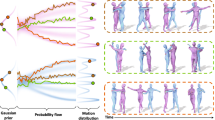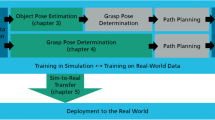Abstract
This paper is intended to solve the motor skills learning, representation and generalization problems in robot imitation learning. To this end, we present an Adapted Curvilinear Gaussian Mixture Model (AdC-GMM), which is a general extension of the GMM. The proposed model can encode data more compactly. More critically, it is inherently suitable for representing data with strong non-linearity. To infer the parameters of this model, a Cross Entropy Optimization (CEO) algorithm is proposed, where the cross entropy loss of the training data is minimized. Compared with the traditional Expectation Maximization (EM) algorithm, the CEO can automatically infer the optimal number of components. Finally, the generalized trajectories are retrieved by an Adapted Curvilinear Gaussian Mixture Regression (AdC-GMR) model. To encode observations from different frames, the sophisticated task parameterization (TP) technique is introduced. All above proposed algorithms are verified by comprehensive tasks. The CEO is evaluated by a hand writing task. Another goal-directed reaching task is used to evaluate the AdC-GMM and AdC-GMR algorithm. A novel hammer-over-a-nail task is designed to verify the task parameterization technique. Experimental results demonstrate the proposed CEO is superior to the EM in terms of encoding accuracy and the AdC-GMM can achieve more compact representation by reducing the number of components by up to 50%. In addition, the trajectory retrieved by the AdC-GMR is smoother and the approximation error is comparable to the Gaussian process regression (GPR) even far fewer parameters need to be estimated. Because of this, the AdC-GMR is much faster than the GPR. Finally, simulation experiments on the hammer-over-a-nail task demonstrates the proposed methods can be deployed and used in real-world applications.
Similar content being viewed by others
References
Billard, A.: Learning motor skills by imitation: a biologically inspired robotic model. Cybern. Syst. 32(1-2), 155–193 (2001)
Billard, A.G., Calinon, S., Dillmann, R.: Learning from Humans. In: Springer handbook of robotics, pp. 1995–2014. Springer (2016)
Calinon, S.: A tutorial on task-parameterized movement learning and retrieval. Intell. Serv. Robot. 9(1), 1–29 (2016)
Calinon, S., Lee, D.: Learning Control. In: Vadakkepat, P., Goswami, A. (eds.) Humanoid robotics: a reference. Springer (2018)
Dillmann, R., Kaiser, M., Ude, A.: Acquisition of elementary robot skills from human demonstration. In: International Symposium on Intelligent Robotics Systems, pp. 185–192 (1995)
Gams, A., Nemec, B., Ijspeert, A.J., Ude, A.: Coupling movement primitives: interaction with the environment and bimanual tasks. IEEE Trans. Robot. 30(4), 816–830 (2014)
Gribovskaya, E., Khansari-Zadeh, S., Billard, A.: Learning non-linear multivariate dynamics of motion in robotic manipulators. Int. J. Robot. Res. 30(1), 80–117 (2011). https://doi.org/10.1177/0278364910376251
Gribovskaya, E., Khansari-Zadeh, S.M., Billard, A.: Learning non-linear multivariate dynamics of motion in robotic manipulators. Int. J. Robot. Res. 30(1), 80–117 (2011)
Ijspeert, A.J., Nakanishi, J., Hoffmann, H., Pastor, P., Schaal, S.: Dynamical movement primitives: learning attractor models for motor behaviors. Neural Comput. 25(2), 328–373 (2013)
Ijspeert, A.J., Nakanishi, J., Schaal, S.: Learning attractor landscapes for learning motor primitives. In: Advances in Neural Information Processing Systems, pp. 1547–1554 (2003)
Ju, Z., Liu, H.: Fuzzy Gaussian mixture models. Pattern Recogn. 45(3), 1146–1158 (2012). https://doi.org/10.1016/j.patcog.2011.08.028
Kaiser, M., Dillmann, R.: Building Elementary Robot Skills from Human Demonstration. In: Proceedings of the 1996 IEEE International Conference on Robotics and Automation, 1996, vol. 3, pp. 2700–2705 (1996)
Khansari-Zadeh, S., Billard, A.: Learning stable nonlinear dynamical systems with gaussian mixture models. IEEE Trans. Robot. 27(5), 943–957 (2011). https://doi.org/10.1109/TRO.2011.2159412
Khansari-Zadeh, S. M., Billard, A.: Learning stable nonlinear dynamical systems with gaussian mixture models. IEEE Trans. Robot. 27(5), 943–957 (2011)
Khansari-Zadeh, S.M., Billard, A.: A dynamical system approach to realtime obstacle avoidance. Auton. Robot. 32(4), 433–454 (2012). The final publication is available at www.springerlink.com
Kober, J., Peters, J.: Reinforcement learning in robotics: a survey, vol. 12, pp 579–610. Springer, Berlin (2012)
Kronander, K., Khansari, M., Billard, A.: Incremental motion learning with locally modulated dynamical systems. Robot. Auton. Syst. 70(C), 52–62 (2015). https://doi.org/10.1016/j.robot.2015.03.010
Lee, J.: A survey of robot learning from demonstrations for human-robot collaboration. arXiv:1710.08789 (2017)
Liu, S., Asada, H.: Teaching and Learning of Deburring Robots Using Neural Networks. In: Proceedings of the 1993 IEEE International Conference on Robotics and Automation, 1993, pp. 339–345 (1993)
Mayer, H., Nagy, I., Knoll, A.: Skill transfer and learning by demonstration in a realistic scenario of laparoscopic surgery. In: Proceedings of the IEEE International Conference on Humanoids CD-ROM. Munich, Germany (2003)
Nakanishi, J., Morimoto, J., Endo, G., Cheng, G., Schaal, S., Kawato, M.: Learning from demonstration and adaptation of biped locomotion. Robot. Auton. Syst. 47(2), 79–91 (2004)
Nguyen-Tuong, D., Peters, J.R., Seeger, M.: Local Gaussian process regression for real time online model learning. In: Advances in Neural Information Processing Systems, pp. 1193–1200 (2009)
Paraschos, A., Daniel, C., Peters, J.R., Neumann, G.: Probabilistic movement primitives. In: Advances in Neural Information Processing Systems, pp. 2616–2624 (2013)
Park, D.H., Hoffmann, H., Pastor, P., Schaal, S.: Movement Reproduction and Obstacle Avoidance with Dynamic Movement Primitives and Potential Fields. In: 2008 8Th IEEE-RAS International Conference on Humanoid Robots. Humanoids 2008, pp. 91–98 (2008)
Rasmussen, C.E.: Gaussian processes in machine learning. In: Advanced Lectures on Machine Learning, pp. 63–71. Springer (2004)
Schaal, S.: Scalable locally weighted statistical techniques for real time robot learning. Appl. Intell. Special Issue Scalable Robot. Appl. Neural Netw. 17, 49–60 (2002)
Schaal, S.: Dynamic movement primitives-a framework for motor control in humans and humanoid robotics. In: Adaptive Motion of Animals and Machines, pp. 261–280. Springer (2006)
Sun, K., Mou, S., Qiu, J., Wang, T., Gao, H.: Adaptive fuzzy control for non-triangular structural stochastic switched nonlinear systems with full state constraints. IEEE Trans. Fuzzy Syst., pp. 1–1 (2018)
Tabor, J., Spurek, P.: Cross-entropy clustering. Pattern Recogn. 47(9), 3046–3059 (2014)
Vakanski, A., Mantegh, I., Irish, A., Janabi-Sharifi, F.: Trajectory learning for robot programming by demonstration using hidden markov model and dynamic time warping. IEEE Trans. Syst. Man Cybern. Part B (Cybernetics) 42(4), 1039–1052 (2012)
Vijayakumar, S., D’Souza, A., Schaal, S.: Incremental online learning in high dimensions. Neural Comput. 17(12), 2602–2634 (2005). https://doi.org/10.1162/089976605774320557
Zeestraten, M., Havoutis, I., Silvério, J., Calinon, S., Caldwell, D.G.: An approach for imitation learning on Riemannian manifolds. IEEE Robot. Autom. Lett. (RA-L) 2(3), 1240–1247 (2017)
Zhang, B., Zhang, C., Yi, X.: Active curve axis gaussian mixture models. Pattern Recognition 38(12), 2351–2362 (2005). https://doi.org/10.1016/j.patcog.2005.01.017
Acknowledgements
Special thanks to my supervisor Prof. Weijia Zhou for his support on this work and Guangyu Zhang for his help on experimental data collection. Thanks to Nailong Liu for his technical support. We also thank the anonymous reviewers for their comments on a preliminary version of this paper.
Author information
Authors and Affiliations
Corresponding author
Additional information
Publisher’s Note
Springer Nature remains neutral with regard to jurisdictional claims in published maps and institutional affiliations.
Appendices
Appendix
Proof of Equation (5)
Proof
According to Theorem 1 we have
So the purpose is to prove
To prove this equation, we include another theorem, which declared that
Theorem 1
Let fbe a density function,\(A:\mathbb {R}^{N} \rightarrow \mathbb {R}^{N}\)isinvertible affine transform, define a transform\(f_{A}: x \rightarrow f(A^{-1}x) / |\det A|\),then we have
where \(\det A\) is the linear component of A. The proof is as follows
□
Defining a transformation A : Σ− 1(x − m) and apply it to both densities in Eq. 5. Let g and f be the transformed densities of μ and \(\mathcal {N}(\boldsymbol {m, {\Sigma }})\), resptectively. Then g is a Gaussian with center mg and covariance Σg and f is a standard normal distribution with zero mean and identity covariance I. Using Theorem 2, we have
where,
where \({\Sigma }_{g} = {\Sigma }^{-1} {\Sigma }_{\mu }\) and \(||m_{g}||^{2} = ||m-m_{\mu }||_{\Sigma }^{2}\). Substituting (30) into Eq. 29 and plug in the value of mg and Σg, we have (5) □
Rights and permissions
About this article
Cite this article
Zhang, H., Leng, Y. Motor Skills Learning and Generalization with Adapted Curvilinear Gaussian Mixture Model. J Intell Robot Syst 96, 457–475 (2019). https://doi.org/10.1007/s10846-019-00999-y
Received:
Accepted:
Published:
Issue Date:
DOI: https://doi.org/10.1007/s10846-019-00999-y




